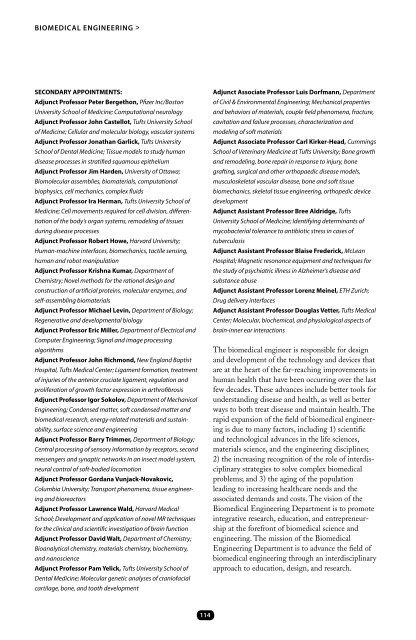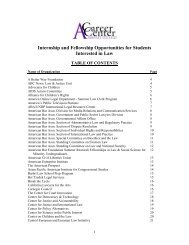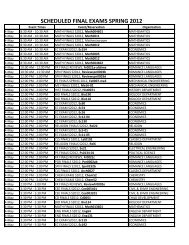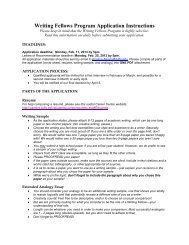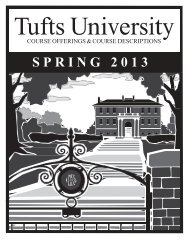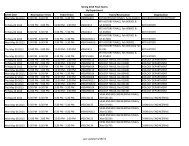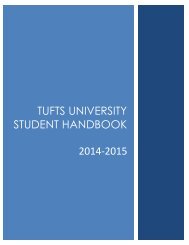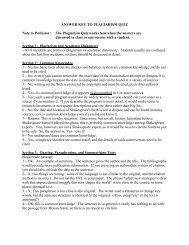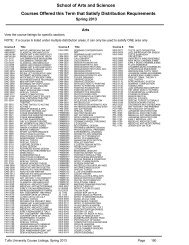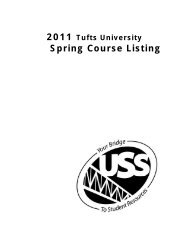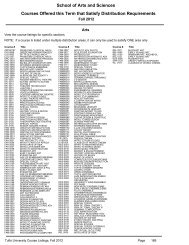2013â2014 The Bulletin - USS at Tufts - Tufts University
2013â2014 The Bulletin - USS at Tufts - Tufts University
2013â2014 The Bulletin - USS at Tufts - Tufts University
Create successful ePaper yourself
Turn your PDF publications into a flip-book with our unique Google optimized e-Paper software.
Biomedical Engineering ><br />
SECONDARY APPOINTMENTS:<br />
Adjunct Professor Peter Bergethon, Pfizer Inc/Boston<br />
<strong>University</strong> School of Medicine; Comput<strong>at</strong>ional neurology<br />
Adjunct Professor John Castellot, <strong>Tufts</strong> <strong>University</strong> School<br />
of Medicine; Cellular and molecular biology, vascular systems<br />
Adjunct Professor Jon<strong>at</strong>han Garlick, <strong>Tufts</strong> <strong>University</strong><br />
School of Dental Medicine; Tissue models to study human<br />
disease processes in str<strong>at</strong>ified squamous epithelium<br />
Adjunct Professor Jim Harden, <strong>University</strong> of Ottawa;<br />
Biomolecular assemblies, biom<strong>at</strong>erials, comput<strong>at</strong>ional<br />
biophysics, cell mechanics, complex fluids<br />
Adjunct Professor Ira Herman, <strong>Tufts</strong> <strong>University</strong> School of<br />
Medicine; Cell movements required for cell division, differenti<strong>at</strong>ion<br />
of the body’s organ systems, remodeling of tissues<br />
during disease processes<br />
Adjunct Professor Robert Howe, Harvard <strong>University</strong>;<br />
Human-machine interfaces, biomechanics, tactile sensing,<br />
human and robot manipul<strong>at</strong>ion<br />
Adjunct Professor Krishna Kumar, Department of<br />
Chemistry; Novel methods for the r<strong>at</strong>ional design and<br />
construction of artificial proteins, molecular enzymes, and<br />
self-assembling biom<strong>at</strong>erials<br />
Adjunct Professor Michael Levin, Department of Biology;<br />
Regener<strong>at</strong>ive and developmental biology<br />
Adjunct Professor Eric Miller, Department of Electrical and<br />
Computer Engineering; Signal and image processing<br />
algorithms<br />
Adjunct Professor John Richmond, New England Baptist<br />
Hospital, <strong>Tufts</strong> Medical Center; Ligament form<strong>at</strong>ion, tre<strong>at</strong>ment<br />
of injuries of the anterior cruci<strong>at</strong>e ligament, regul<strong>at</strong>ion and<br />
prolifer<strong>at</strong>ion of growth factor expression in arthrofibrosis<br />
Adjunct Professor Igor Sokolov, Department of Mechanical<br />
Engineering; Condensed m<strong>at</strong>ter, soft condensed m<strong>at</strong>ter and<br />
biomedical research, energy-rel<strong>at</strong>ed m<strong>at</strong>erials and sustainability,<br />
surface science and engineering<br />
Adjunct Professor Barry Trimmer, Department of Biology;<br />
Central processing of sensory inform<strong>at</strong>ion by receptors, second<br />
messengers and synaptic networks in an insect model system,<br />
neural control of soft-bodied locomotion<br />
Adjunct Professor Gordana Vunjack-Novakovic,<br />
Columbia <strong>University</strong>; Transport phenomena, tissue engineering<br />
and bioreactors<br />
Adjunct Professor Lawrence Wald, Harvard Medical<br />
School; Development and applic<strong>at</strong>ion of novel MR techniques<br />
for the clinical and scientific investig<strong>at</strong>ion of brain function<br />
Adjunct Professor David Walt, Department of Chemistry;<br />
Bioanalytical chemistry, m<strong>at</strong>erials chemistry, biochemistry,<br />
and nanoscience<br />
Adjunct Professor Pam Yelick, <strong>Tufts</strong> <strong>University</strong> School of<br />
Dental Medicine; Molecular genetic analyses of craniofacial<br />
cartilage, bone, and tooth development<br />
Adjunct Associ<strong>at</strong>e Professor Luis Dorfmann, Department<br />
of Civil & Environmental Engineering; Mechanical properties<br />
and behaviors of m<strong>at</strong>erials, couple field phenomena, fracture,<br />
cavit<strong>at</strong>ion and failure processes, characteriz<strong>at</strong>ion and<br />
modeling of soft m<strong>at</strong>erials<br />
Adjunct Associ<strong>at</strong>e Professor Carl Kirker-Head, Cummings<br />
School of Veterinary Medicine <strong>at</strong> <strong>Tufts</strong> <strong>University</strong>; Bone growth<br />
and remodeling, bone repair in response to injury, bone<br />
grafting, surgical and other orthopaedic disease models,<br />
musculoskeletal vascular disease, bone and soft tissue<br />
biomechanics, skeletal tissue engineering, orthopedic device<br />
development<br />
Adjunct Assistant Professor Bree Aldridge, <strong>Tufts</strong><br />
<strong>University</strong> School of Medicine; Identifying determinants of<br />
mycobacterial tolerance to antibiotic stress in cases of<br />
tuberculosis<br />
Adjunct Assistant Professor Blaise Frederick, McLean<br />
Hospital; Magnetic resonance equipment and techniques for<br />
the study of psychi<strong>at</strong>ric illness in Alzheimer’s disease and<br />
substance abuse<br />
Adjunct Assistant Professor Lorenz Meinel, ETH Zurich;<br />
Drug delivery interfaces<br />
Adjunct Assistant Professor Douglas Vetter, <strong>Tufts</strong> Medical<br />
Center; Molecular, biochemical, and physiological aspects of<br />
brain-inner ear interactions<br />
<strong>The</strong> biomedical engineer is responsible for design<br />
and development of the technology and devices th<strong>at</strong><br />
are <strong>at</strong> the heart of the far-reaching improvements in<br />
human health th<strong>at</strong> have been occurring over the last<br />
few decades. <strong>The</strong>se advances include better tools for<br />
understanding disease and health, as well as better<br />
ways to both tre<strong>at</strong> disease and maintain health. <strong>The</strong><br />
rapid expansion of the field of biomedical engineering<br />
is due to many factors, including 1) scientific<br />
and technological advances in the life sciences,<br />
m<strong>at</strong>erials science, and the engineering disciplines;<br />
2) the increasing recognition of the role of interdisciplinary<br />
str<strong>at</strong>egies to solve complex biomedical<br />
problems; and 3) the aging of the popul<strong>at</strong>ion<br />
leading to increasing healthcare needs and the<br />
associ<strong>at</strong>ed demands and costs. <strong>The</strong> vision of the<br />
Biomedical Engineering Department is to promote<br />
integr<strong>at</strong>ive research, educ<strong>at</strong>ion, and entrepreneurship<br />
<strong>at</strong> the forefront of biomedical science and<br />
engineering. <strong>The</strong> mission of the Biomedical<br />
Engineering Department is to advance the field of<br />
biomedical engineering through an interdisciplinary<br />
approach to educ<strong>at</strong>ion, design, and research.<br />
114


